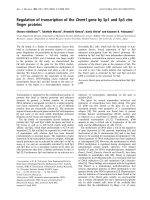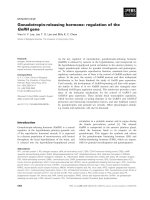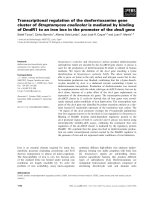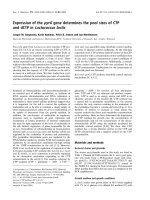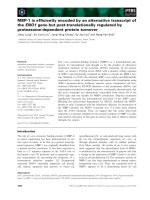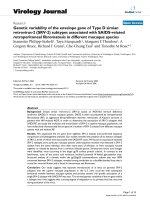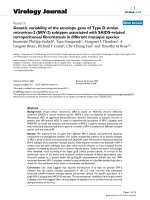Diet-induced variability of the resistin gene (Retn) transcript level and methylation profile in rats
Bạn đang xem bản rút gọn của tài liệu. Xem và tải ngay bản đầy đủ của tài liệu tại đây (1.03 MB, 7 trang )
Nowacka-Woszuk et al. BMC Genetics (2015) 16:113
DOI 10.1186/s12863-015-0270-4
RESEARCH ARTICLE
Open Access
Diet-induced variability of the resistin gene (Retn)
transcript level and methylation profile in rats
Joanna Nowacka-Woszuk1, Ewa Pruszynska-Oszmalek2, Maciej Szydlowski1, Slawomir Sadkowski1
and Izabela Szczerbal1*
Abstract
Background: Adipose tissue is recognized as a highly active metabolic and endocrine organ. The hormones
secreted by this tissue play an important role in many biochemical processes. It is known that dysfunction of
adipocytes can cause insulin resistance, type 2 diabetes or hyperlipidemia. One of the important factors produced
in fat tissue is resistin (Retn). It has been postulated that this hormone is involved in glucose homeostasis and insulin
resistance. In the present study, the impact of five diet types (ad libitum normal, restricted, high-carbohydrate, high-fat
and high-protein) on the Retn gene transcription and methylation profile was evaluated in rats of different ages.
Results: Transcript levels and methylation status of the Retn gene were studied in three tissues (muscle, subcutaneous
and abdominal fat) in rats at 30, 60 and 120 days of age. We found an effect of tissue type on the Retn transcription in
all diet types, as well as an effect of feeding type and age on the mRNA levels for high-fat and high-protein diets. The
DNA methylation levels depended only on tissue type.
Conclusions: The obtained results demonstrate a tissue-specific expression pattern and a characteristic DNA
methylation profile of the Retn gene in rats. Retn expression seems to be sensitive to nutritional changes, but only in
the case of high-fat and high-protein diets. Moreover, an effect of age on Retn mRNA content was observed in these
diets. Because no correlation between the transcript level and methylation status was found, we assumed that the
transcription control of this gene by DNA methylation of the promoter seems to be unlikely.
Keywords: Resistin, Rat, Obesity, Diets, Gene expression, DNA methylation
Background
Obesity is a growing problem worldwide, which results
in an increasing number of diagnosed type 2 diabetes
characterized by insulin resistance. Adipose tissue is not
only an energy reservoir, but also plays an important role
as an endocrine organ. It secretes many adipokines, such
as leptin, resistin (Retn), adiponectin, visfatin, apelin,
and omentin, as well as sex steroids and various growth
factors. Retn is cysteine-rich protein belonging to the
RELMs (resistin-like molecules) family. The genetic
structure of the Retn gene varies between mammals and
the similarity in the coding sequence ranges from approximately 60 % for rodents to 80 % for livestock [1].
The expression of this gene in rodents occurs mostly in
mature adipocytes, but it was also found in other tissues.
* Correspondence:
1
Department of Genetics and Animal Breeding, Poznan University of Life
Sciences, Wolynska 33, 60-637 Poznan, Poland
Full list of author information is available at the end of the article
Retn is considered a factor linking obesity and insulin
resistance. In obesity, its expression increases, leading to
enhanced resistance of tissues to insulin [2].
An interesting issue is how different factors, such as
nutrition or age, can modulate expression of the Retn
gene. It is known that diet type has an influence on Retn
mRNA as well as serum levels in rodents. In mice during
fasting the Retn mRNA in the adipose tissue is reduced,
while upon refeeding transcription increases. Fasting
also reduces circulating Retn concentrations. Conversely,
in diet-induced obese mice serum Retn levels are enhanced, while transcription of the Retn gene is decreased
(for a review see: [3]). It is also well documented that
aging is associated with changes in gene expression
levels in many tissues, including adipose tissue [4].
Moreover, it has been shown that aging leads to both
global and local alterations in the DNA methylation
profile [5].
© 2015 Nowacka-Woszuk et al. Open Access This article is distributed under the terms of the Creative Commons Attribution
4.0 International License ( which permits unrestricted use, distribution, and
reproduction in any medium, provided you give appropriate credit to the original author(s) and the source, provide a link to
the Creative Commons license, and indicate if changes were made. The Creative Commons Public Domain Dedication waiver
( applies to the data made available in this article, unless otherwise stated.
Nowacka-Woszuk et al. BMC Genetics (2015) 16:113
Bearing in mind the role of Retn in the development of
obesity, many studies have been performed on animals
fed with a high-fat diet (HFD) to serve as a model for human obesity. Such studies, conducted by Kim and Park
[6], found that insulin resistance, dyslipidemia and fatty
liver developed in rats with obesity induced by HFD. The
authors analyzed the expression levels of different genes
in adipose tissue and found that among many genes, Retn,
TNF-α and leptin expression levels were upregulated 1.5-,
3.4- and 7.0-fold, respectively, in rats on a HFD when
compared with the control group. Interesting studies
concerning changes in Retn expression depending on the
age of animals were performed by Oliver [7]. They
analyzed site-specific Retn expression patterns from 4
different depots (epididymal, inguinal, mesenteric and
retroperitoneal) of white adipose tissue (WAT) and brown
adipose tissue (BAT), as well as circulating Retn levels.
The analysis covered the period from suckling to 1 year
of age. In general, it was noticed that in BAT and retroperitoneal WAT, Retn transcription levels were higher
than in epididymal, inguinal, and mesenteric WAT
depots. Moreover, at 2 months old the mRNA levels
decreased in inguinal WAT and increased in epididymal
and retroperitoneal WAT. These time-specific differences
could be explained by the change of feeding from suckling
to a chow diet. However, the Retn transcript levels in BAT
were quite stable during the study period, while the
circulating levels increased during development as a result
of the increasing body fat content [7]. The results
mentioned above suggest sensitivity of the Retn expression
to nutritional changes.
So far, many studies concerning Retn in the rat focused
only on protein levels and incomplete information about
transcript levels of the gene is available. Also, most studies tested HFDs; knowledge about other feeding types
is quite limited. Thus, the aim of this study was the
comprehensive analysis of the impact of different diets and age on Retn transcript levels. Moreover, given
the lack of data concerning the epigenetic mechanisms
regulating its expression, we also analyzed the DNA
methylation profile. The study was performed on two
types of adipose tissue, as well as muscle tissues, in
animals of different ages.
Methods
Ethics statement
Tissue sampling was carried out according to standard
Polish veterinary protocols. All animal experiments were
approved by the local Bioethical Commission for Animal
Care and Use in Poznan, Poland (approval No: 7/
2009).Treatment of animals was in accordance with the Arrive Guidelines for Reporting Animal Research (Additional
File 1: ARRIVE Checklist).
Page 2 of 7
Animals and diets
Male Wistar rats (180 ± 10 g in weight) from Lab Animal
Breeding (Brwinow, Poland) were housed under standard
conditions (22 ± 2 °C; 12-h light/dark cycles) with
unlimited access to water. After 10 days of adaptation, the
animals were assigned to 6 different groups (A–F) in
terms of diet, divided in two separate experiments. In experiment 1, the animals received one of the following
diets: group A = ad libitum normal diet Labofed B; group
B = restricted diet (i.e., 75 % dose compared with group
A); and group C = high-carbohydrate diet (i.e., normal
diet + 40 % starch). In experiment 2, the animals received
one of the follow diets: group D = ad libitum normal diet
Labofed B; group E = high-fat diet (i.e., normal diet + 20 %
triglycerides); and group F = high-protein diet (i.e., normal
diet + 20 % soy protein). All animals were euthanized by
decapitation. Tissue samples (muscle = MT, subcutaneous fat = ST, and abdominal fat = AFT) from each of the
diet groups were collected at three time points (30, 60
and 120 days of age). Each diet*age group consisted of 8
animals.
Expression analysis
RNA was extracted in two independent technical replicates with the use of TriPure Isolation Reagent (Roche)
according to a standard procedure. An aliquot of 2 ug of
RNA was reversely transcribed using the Transcriptor
High Fidelity cDNA Synthesis kit (Roche). The semiquantitative transcript level analysis was performed in
duplicate using the Fast Start DNA MasterPlus SYBR
Green I kit (Roche) on a capillary real-time PCR LightCycler 2.0 (Roche). The relative transcript level was calculated after correction via transcript levels of two reference
genes (Hypoxanthine-guanine phosphoribosyltransferase
[Hprt] and TATA box binding protein [Tbp]) using
standard curves designed for all analyzed genes [8]. The
primer sequences and amplicon lengths are shown in
Table 1. Representative qPCR amplification and melting
curves are presented in Additional file 2: Figure S1.
Methylation analysis and detection of CpG islands
The region 2 Kb upstream of the Retn gene was selected for CpG island searching with the use of the
Cpgplot software ( />emboss_cpgplot/). Using standard criteria (Obs/Exp ratio > 0.6; min. C + G content 50 %; length min. 200 bp), no
CpG islands were identified. Thus, we decided to reduce
the minimum length of the island to 100 bp. A similar approach was applied in studies concerning the human RETN
gene [9], where a small CpG island (162 bp) located upstream of the RETN gene was analyzed. Applying reduced
size criteria, we identified a region of 140 bp as a potential
CpG island located from −945 to −1193 bp upstream of the
first exon of the rat Retn gene. The primers were designed
Nowacka-Woszuk et al. BMC Genetics (2015) 16:113
Page 3 of 7
Table 1 PCR primer sequences, amplicon length and annealing temperature used in Retn gene analysis
Type of analysis
Gene
Primer sequence
Amplicon length
Anneal.temp.
Transcript level analysis
Retn
F: 5′ CCACGTACTTAACAGGATG 3′
195 bp
62 °C
Hprt
F: 5′ CAGTCAACGGGGGACATAAAAG 3′
146 bp
62 °C
190 bp
62 °C
249 bp
56 °C
R: 5′ GAGGAGACTGACCAGCAAT 3′
R: 5′ ATTTTGGGGCTGTACTGCTTGA 3′
Tbp
F: 5′ ATCCTTCACCAATGACTCCTATG 3′
Retn
F: 5′ GTGGAAAGGAGGAATGTATTATTTG3′
R: 5′ ATGATGACTGCAGCAAACC 3′
Methylation analysis (converted sequence)
R: 5′ACAAATAAAAAAACTTTAATATTTATTCA3′
Reference sequences for the Retn - GenBank: NC_005111.3; the Hprt - GenBank: S79292 and the Tbp – GenBank:NM_001004198
using MethPrimer software ( The amplified fragment
249 bp in length overlapped 13 CG dinucleotides in the
CpG island (Fig. 1). The primer sequences are shown in
Table 1. DNA was extracted using a standard protocol
with the phenol:chloroform:isoamyl alcohol acid mixture (25:24:1, Sigma). The quality and quantity of isolates were controlled using the Nanodrop. Using the EZ
DNA Methylation kit (ZymoResearch), 1 ug of DNA
was bisulfite converted. After conversion, the touch-down
amplification was performed (annealing temperature reduced from 60° to 56 °C every first 8 cycles, the following
32 cycles at 56 °C). PCR products were cloned into the
pGEM T-Easy vector (Promega) following the transformation of DH5α competent cells (Invitrogen) according to
the supplier’s protocol. Transformed cells were harvested
on agar plates (37 °C, overnight) with X-Gal, IPTG and
ampicillin. For each sample, 12–16 white colonies were
selected and amplified overnight with the Illustra TempliPhi Amplification Kit (GE Healthcare). Afterwards,
the clones were sequenced using the Big Dye Terminator
v1.1 Sequencing kit (Life Technologies) on the Genetic
Analyzer 3130 (Applied Biosystems). The methylation
level was calculated as a mean for at least 8 clones with the
use of QUMA software ( />Statistical analysis
Associations between diets and transcript levels, as well
as diets and methylation levels, were evaluated using linear fixed models. The models for both experiments were
identical. We started from long models the included the
tissue, age (as a factor), diet and three two-way interactions between these variables as fixed factors. Because in
experiment 1 we obtained only one significant effect of
interaction (diet-by-age; P = 0.028) and for experiment
2 we did not calculate any significant effects of
Fig. 1 The fragment of 249 bp in the 5′ flanking region of the Retn gene analyzed in DNA methylation studies (upper line: sequence before BS
conversion; lower line: sequence after BS conversion; underlined: primer sequence; in the box: CG dinucleotides)
Nowacka-Woszuk et al. BMC Genetics (2015) 16:113
interactions, we excluded all interactions effects from
the models. To obtain a normal distribution of residuals
in an ANOVA, the data concerning the transcript level
were logarithmically transformed. Normality of the distribution was tested by the Kolmogorov–Smirnov test.
The linear relationship between transcript (in log scale)
and methylation levels was expressed as Pearson’s correlation after adjusting for fixed effects. To adjust for fixed
effects, both traits were first analyzed in the linear models
described above and residuals were extracted for correlation calculation. All statistical calculations and plots
were performed using R software v3.1.1 (R Development
Core Team).
Results and discussion
Retn gene transcript levels in restricted and highcarbohydrate diets versus control
The relative transcript level of the Retn was analyzed in
three tissues (MT, ST and AFT) and the highest concentration was found in both fat tissues, while in MT it was almost a hundred times lower. In experiment 1, in which
three feeding types were compared [normal (A), restricted
(B) and high-carbohydrate (C) diets], the statistical analysis
showed significant differences in transcript levels depending
on tissue type (P = 1.7 × 10−13). There was no effect of the
diet type (P = 0.129) or age of the animals (P = 0.142). However, in the restricted diet group an increase in transcription
was noticed in AFT and MT at 60 days of age. This is in
agreement with previous findings described by Oliver [6],
in which an increase of Retn mRNA levels (in 2-month-old
rats) was found in epididymal and retroperitoneal WAT.
Those authors observed similar results also for other genes
such as Leptin or UPC2 for different depots of WAT. They
explained that this type of reaction could have been caused
by the feeding system change (from milk to chow diet). The
impact of food restriction versus an ad libitum diet on the
mRNA levels of the Retn gene in three age groups of rats
(3, 8 and 24 months old) was analyzed by Fernandez [10].
In ad libitum fed animals, they found a significant reduction of mRNA levels in epididymal visceral adipose tissue
(VAT) in 8- and 24-month-old rats when compared with
3-month-old animals, while there was no effect of age in
retroperitoneal VAT. Conversely, food restriction resulted
in a greater decrease of Retn transcript contents in 8- than
3-month-old animals in both analyzed VAT depots, while
in 24-month-old rats the mRNA levels were much higher
than in 8-month-old ones. Food restriction in terms of the
Retn and adiponectin expression in VAT and ST adipose
tissue was also studied by Milan [11]. They compared lean
and obese (Zucker) rats. The authors observed a significant reduction of adiponectin and Retn expression levels
only in VAT of obese rats when compared with lean ones.
After food restriction, the adiponectin expression levels
Page 4 of 7
were restored to the normal, in contrast with Retn, for
which levels decreased continuously.
In the high-carbohydrate diet, we noticed a decrease
of the transcript levels in ST and MT depending on
the age of the animal, in contrast with AFT fat where it increased; however, the observed trends were not significant
(data not shown). This type of diet was also analyzed by
Stroubini [12], who investigated serum Retn concentrations. These authors found that a high-carbohydrate diet
reduced circulating levels of Retn when compared with
high-fat and high-protein feeding. Unfortunately, they did
not test the tissue Retn transcript levels; thus, it is hard to
compare their results with our observations. A highsucrose diet was studied by Polson and Thompson [13];
however, the authors did not notice any significant effects
of this type of diet on mRNA levels of Retn in WAT,
which is in agreement with our results.
Retn gene transcript levels in high-fat and high-protein
diets versus control
In experiment 2, we tested normal (D), high-fat (E)
and high-protein (F) diets and the statistical analysis
showed significant differences in transcript levels in
terms of tissue type (P = 5.8 × 10−12), diet (P = 0.030)
and age of the animals (P = 0.048). In detail, in group
E (high-fat), Retn transcript levels decreased with the
age of the animals in all analyzed tissues. In the highprotein diet (F) group, mRNA levels increased in ST
and decreased in AFT depending on the age of the
animals (Fig. 2). When comparing diets from experiment 2, we noticed that in all the tissues the highest
mRNA levels of Retn were observed in the highprotein diet group (E) in contrast with the high-fat
diet, for which transcription was lower than in the
other feeding regimens, especially over the long-term
(Fig. 3). Similar diets were applied by Stroubini [12],
who tested three diets for 13 weeks in rats: high fat
(HFD), high carbohydrate (HCD) and high protein
Fig. 2 The Retn transcript levels in terms of animal’s age in all analyzed
tissues (MT = muscle; ST = subcutaneous fat; AFT = abdominal fat) in
high-fat (E) and high-protein (F) diets
Nowacka-Woszuk et al. BMC Genetics (2015) 16:113
Page 5 of 7
Fig. 3 A comparison of Retn mRNA levels in terms of diets (D = normal; E = high-fat; F = high-protein) and age in three analyzed tissues
(MT = muscle; ST = subcutaneous fat; AFT = abdominal fat)
(HPD) diets. Moreover, after 10 weeks of dietary manipulation, the animals received sibutramine, a drug usually
administered in humans with exogenous obesity, at two
different doses. The authors measured body weight and
the fat/lean ratio, as well as serum adiponectin and Retn
concentrations. They found that a HFD elevated body
weight and the fat/lean ratio; however, after drug treatment at the higher dose the fat/lean ratio was reduced in
the HCD and HPD groups only, probably as an effect of
appetite suppression. Serum adiponectin levels were
higher after sibutramine administration in the HFD group
compared with the HCD and HPD groups, while Retn
concentrations were not altered by drug treatment in any
diet type. No tissue Retn transcript level analysis was
undertaken in that study [12], so we are not able to compare the results with our data.
The effects of a HFD (cafeteria diet, CAF) was analyzed
by Ribot [14], who measured serum as well as tissue adiponectin and Retn levels in rats of both sexes. mRNA
levels were analyzed in different WAT depots: gonadal,
retroperitoneal (visceral) and inguinal (subcutaneous). It
was found that the CAF diet increased energy intake and
weight of adipose tissue (more significantly in females).
Moreover, the effective adiponectin and Retn production
(the parameter calculated as a serum level of both adipokines divided by the total weight of WAT depots) was decreased in the CAF group. In three WAT depots, there
was no difference in adiponectin mRNA levels in response
to the CAF diet. In agreement with our findings, the
Retn transcript levels were reduced in CAF-fed male
and female rats in gonadal WAT depots. A similar
trend (although non-significant) was also observed for
females in retroperitoneal and inguinal WAT, suggesting
sex specific differences [14].
Methylation analysis of the Retn gene
We also performed methylation analysis for diet*age
samples in three studied tissues and found that
methylation status was dependent on tissue type (P =
0.0057). The lowest level of methylation was observed
in MT, while it was highest in AFT (Figs. 4 and 5). We
did not notice any effect of diet (P = 0.363) or age of
the animals (P = 0.829) on methylation levels. Moreover, no correlation was found between the transcript
level and methylation (rg = 0.027). There is an increasing amount of data that environmental factors may
alter gene expression profiles through epigenetic mechanisms [15]. However, it seems that the impact of such factors on the epigenome depends on developmental stages.
It is widely accepted that the gestational period is especially susceptible to epigenetic modifications. Many studies have focused on the role of early life nutrition on
the modulation of DNA methylation [16]. It has been
Fig. 4 DNA methylation levels depending on tissue types
(MT = muscle; ST = subcutaneous fat; AFT = abdominal fat) in all
diet*age groups jointly
Nowacka-Woszuk et al. BMC Genetics (2015) 16:113
Page 6 of 7
Fig. 5 DNA methylation analysis in the F diet (high-protein) at 60 days of age (% of methylation: a 44.6 % in muscle; b 51 % in subcutaneous fat;
c 78.5 % in abdominal fat); black dot = cytosine methylated, white dot = cytosine unmethylated
found that dietary components (e.g., folate, vitamin B6
and B12, methionine), which affect the amount of the universal methyl donor S‑adenosylmethionine (SAM), can
change the methylation profile of particular genes and
have long-term effects on the epigenome of the offspring
[17]. Conversely, environmental factors acting postnatally
are restricted only to adult cells or, in case of adult stem
cells, to a specific tissue. Although the epigenome of fully
differentiated cells is more stable and not very susceptible
to environmental signals, there are reports showing that
postnatal diets also influence DNA methylation. For example, a methyl donor–deficient diet post-weaning affected the methylation status of the Igf2 gene in mice
[18] or mice fed a HFD from weaning has shown a significant increase in DNA methylation in the promoter of
the μ-opioid receptor [19]. In addition, application of
genome-wide DNA methylation methods allowed the
detection of changes in the methylation profile of adipose tissue after intervention, such as exercise [20] or
weight loss following gastric bypass [21].
Interesting studies including epigenetic factors were
undertaken by Satoor [22]. Firstly, they analyzed the
transcript levels of different adipokines in 8 adipose fat
depots and observed that mRNA concentrations of adiponectin, leptin, Retn and visfatine genes were 10,000
to a million-fold lower in VAT than in ST. Thus, the
authors performed an autologous transplantation of
VAT into peripheral (ST) sites to determine the metabolic effects. After transplantation into thigh or chest
regions, the transcription levels of four studied genes
increased in the VAT grafts. To verify if the observed
changes were an effect of higher expression or lower
mRNA degradation, the authors performed ChIP analysis
to check the histone-methylation antibodies to active
(H3K4) or inactive (H3K9) marks of lysine methylation.
They found that promoter regions of the studied genes acquired methylation at H3K4me2 after transplantation.
This region recruits less LSD1 and/or KMT1a enzymes,
known as regulators of chromatin compaction and
transcription repressors, causing an increase of transcription in grafts when compared with the original depots. Unfortunately, the authors did not determine the
DNA methylation profiles [22]. In our studies, we did
not analyze histone modifications; however, the regulation of Retn transcription through this mechanism
could be possible. Because the Retn locus is poor in CG
rich regions, we have analyzed only a small fragment
upstream of the gene. However, it cannot be excluded
that other CpG islands located near or within the Retn
gene may also influence expression via other than classic promoter regulation mechanisms. Based on the
Genome Browser Database ( />index.html) for humans, it has been shown that a CpG
island of the RETN is located within the gene body.
Our analysis of the corresponding region in the rat genome did not indicate such a sequence. It can be expected that the availability of more accurate databases
for the rat will allow the identification of other potential CpG islands in the Retn locus.
Conclusions
Based on the obtained results, we can conclude that tissue
type has the highest significance for Retn transcript levels.
Diet- and age-induced alternations in transcript levels
were observed in HFD and HPD. However, no influence
of diet on DNA methylation and no correlation of methylation with transcript levels were observed. Thus, we assume that transcription regulation of the rat Retn gene by
DNA methylation of its promoter is doubtful. However, it
cannot be excluded that other CpG islands are involved in
Retn regulation; however, the lack of information concerning their location makes such analysis difficult. Also, other
epigenetic processes, including histone modifications,
should be taken into consideration.
Additional files
Additional file 1: ARRIVE checklist. (PDF 369 kb)
Additional file 2: Figure S1. Representative qPCR amplification curves
of serial dilutions and melting curves of the Retn gene (A and B) as well
as two reference genes: Hprt (C and D) and Tbp (E and F). (BMP 5071 kb)
Competing interests
The authors declare that they have no competing interests.
Authors’ contributions
JNW carried out the molecular analysis (transcription experiments and DNA
methylation analysis) and drafted the manuscript; EPO coordinated the
Nowacka-Woszuk et al. BMC Genetics (2015) 16:113
animal feeding experiments and collected the tissues; MS and SS performed
the statistical analysis; IS carried out the molecular analysis, transcriptional
experiments and drafted the manuscript. All authors read and approved the
final manuscript.
Acknowledgments
This study was supported by the Polish Ministry of Science and Higher
Education, project no. N N303 551639. Special thanks to Prof. M. Switonski,
Head of the Department of Genetics and Animal Breeding, for scientific
support and his valuable comments during the realization of the project.
Author details
1
Department of Genetics and Animal Breeding, Poznan University of Life
Sciences, Wolynska 33, 60-637 Poznan, Poland. 2Department of Animal
Physiology and Biochemistry, Poznan University of Life Sciences, Wolynska
35, Poznan 60-637, Poland.
Page 7 of 7
18. Waterland RA, Lin JR, Smith CA, Jirtle RL. Post-weaning diet affects genomic
imprinting at the insulin-like growth factor 2 (Igf2) locus. Hum Mol Genet.
2006;15:705–16.
19. Vucetic Z, Kimmel J, Reyes TM. Chronic high-fat diet drives postnatal
epigenetic regulation of μ-opioid receptor in the brain.
Neuropsychopharmacology. 2011;36:1199–206.
20. Ronn T, Volkov P, Davegardh C, Dayeh T, Hall E, Olsson AH, et al. A six
months exercise intervention influences the genome-wide DNA
methylation pattern in human adipose tissue. PLoS Genet. 2013;9:e1003572.
21. Benton MC, Johnstone A, Eccles D, Harmon B, Hayes MT, Lea RA, et al. An
analysis of DNA methylation in human adipose tissue reveals differential
modification of obesity genes before and after gastric bypass and weight
loss. Genome Biol. 2015;16:8.
22. Satoor SN, Puranik AS, Kumar S, Williams MD, Ghale M, Rahalkar A, et al.
Location, location, location: Beneficial effects of autologous fat transplantation.
Sci Rep. 2011;1:81.
Received: 5 June 2015 Accepted: 10 September 2015
References
1. Sassek M, Pruszynska-Oszmalek E, Nowacka-Woszuk J, Szczerbal I,
Szczepankiewicz D, Kaczmarek P, et al. Resistin - from gene expression to
development of diabetes. J Biol Regul Homeost Agents. 2013;27:647–54.
2. Li Y, Ding L, Hassan W, Abdelkader D, Shang J. Adipokines and hepatic
insulin resistance. J Diabetes Res. 2013; doi:10.1155/2013/170532.
3. Park HK, Ahima RS. Resistin in rodents and humans. Diabetes Metab J.
2013; doi:10.4093/dmj.2013.37.6.404.
4. Glass D, Viñuela A, Davies MN, Ramasamy A, Parts L, Knowles D, et al. Gene
expression changes with age in skin, adipose tissue, blood and brain.
Genome Biol. 2013;14(7):R75.
5. Marttila S, Kananen L, Häyrynen S, Jylhävä J, Nevalainen T, Hervonen A, et al.
Ageing-associated changes in the human DNA methylome: genomic
locations and effects on gene expression. BMC Genomics. 2015;16:179.
6. Kim YJ, Park T. Genes are differentially expressed in the epididymal fat of
rats rendered obese by a high-fat diet. Nutr Res. 2008;28:414–22.
7. Oliver P, Picó C, Serra F, Palou A. Resistin expression in different adipose
tissue depots during rat development. Mol Cell Biochem. 2003;252:397–400.
8. Vandesompele J, De Preter K, Pattyn F, Poppe B, Van Roy N, De Paepe A, et
al. Accurate normalization of real-time quantitative RT-PCR data by
geometric averaging of multiple internal control genes. Genome Biol.
2002;18(7):3. RESEARCH0034.
9. Rong C, Cui X, Chen J, Qian Y, Jia R, Hu Y. DNA methylation profiles in
placenta and its association with gestational diabetes mellitus. Exp Clin
Endocrinol Diabetes. 2015;123:282–8.
10. Fernández CM, Moltó E, Gallardo N, del Arco A, Martínez C, Andrés A, et al.
The expression of rat resistin isoforms is differentially regulated in visceral
adipose tissues: effects of aging and food restriction. Metabolism.
2009;58:204–11.
11. Milan G, Granzotto M, Scarda A, Calcagno A, Pagano C, Federspil G, et al.
Resistin and adiponectin expression in visceral fat of obese rats: effect of
weight loss. Obes Res. 2002;10:1095–103.
12. Stroubini T, Perelas A, Liapi C, Perrea D, Dontas I, Tzavara C, et al. Serum
adiponectin and resistin in rats under three isocaloric diets: The effect of
sibutramine. Cytokine. 2009;46:171–5.
13. Polson DA, Thompson MP. Adiponutrin mRNA expression in white adipose
tissue is rapidly induced by meal-feeding a high-sucrose diet. Biochem
Biophys Res Commun. 2003;301:261–6.
14. Ribot J, Rodríguez AM, Rodríguez E, Palou A. Adiponectin and resistin
response in the onset of obesity in male and female rats. Obesity.
2008;16:723–30.
15. Feil R, Fraga MF. Epigenetics and the environment: emerging patterns and
implications. Nat Rev Genet. 2012;13:97–109.
16. Sie KK, Li J, Ly A, Sohn KJ, Croxford R, Kim YI. Effect of maternal and
postweaning folic acid supplementation on global and gene-specific
DNA methylation in the liver of the rat offspring. Mol Nutr Food Res.
2013;57:677–85.
17. Ruemmele FM, Garnier-Lengliné H. Why are genetics important for
nutrition? Lessons from epigenetic research. Ann Nutr Metab. 2012;60
Suppl 3:38–43.
Submit your next manuscript to BioMed Central
and take full advantage of:
• Convenient online submission
• Thorough peer review
• No space constraints or color figure charges
• Immediate publication on acceptance
• Inclusion in PubMed, CAS, Scopus and Google Scholar
• Research which is freely available for redistribution
Submit your manuscript at
www.biomedcentral.com/submit

